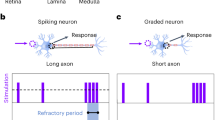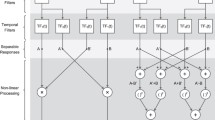Abstract
Motion perception is arguably a fundamental mechanism used by natural species to accomplish a number of tasks, such as navigating freely in an unknown environment. Traditional motion perception methods tend to be computationally intensive, requiring powerful computers and large memories. However, by copying biological mechanisms, such as elementary motion discrimination at the early stages of the visual processing paths, it should be possible to build small and efficient motion perception systems. This paper describes the manner in which a simple motion perception model based on the insect visual system has been implemented using mixed analog/digital VLSI. The device has been fabricated in a 2 micron double metal, double polysilicon process, and comprises 61 photo-detectors, and associated analog and digital circuitry. While not entirely successful in that component mismatches hamper the detection of dark-to-bright changes in contrast, the results clearly show the feasibility of using such a device in autonomous control systems.
Similar content being viewed by others
References
C. Mead, Analog VLSI and Neural Systems. Addison-Wesley, 1989.
S. Huang and A.N. Netravali, “Motion and structure from feature correspondences: A review,” in Proceedings of the IEEE82(2), 1994, pp. 252-268.
A. Singh, Optic flow computation: A unified perspective. IEEE Computer Society Press, 1991.
T. Poggio, V. Torre, and C. Koch, “Computational vision and regularisation theory.” Nature317, pp. 314-319, 1985.
C. Koch, “Seeing chips: Analog VLSI circuits for computer vision.” Neural Computation1, pp. 184–200, 1989.
A. Yakovleff, D. Abbott, X.T. Nguyen, and K. Eshraghian, “Obstacle avoidance and motion-induced navigation,” in Proc. Computer Architectures for Machine Perception Workshop, Como, Italy, 1995, pp. 384-393.
A. Yakovleff, “Architectural studies for visual processing,” PhD Thesis, Department of Electrical and Electronic Engineering, The University of Adelaide, 1995.
K. Nakayama, “Biological image motion processing: A review.” Vision Research25(5), pp. 625-660, 1985.
W. Reichardt and T. Poggio, “Figure-ground discrimination by relative movement in the fly visual system.” Biological Cybernetics35, pp. 81-100, 1979.
J. B. Mulligan, “Nonlinear combination rules and the perception of visual motion transparency.” Vision Research33(14), pp. 2021-2030, 1993.
E. C. Sobel, “The locust's use of motion parallax to measure distance.” Journal of Comparative Physiology A167, pp. 579-588, 1990.
D. Regan and K.I. Beverley, “Looming detectors in the human visual pathway.” Vision Research18(4), pp. 415-421, 1978.
D. Regan and S. J. Hamstra, “Dissociation of discrimination thresholds for time to contact and for rate of angular expansion.” Vision Research33(4), pp. 447-462, 1993.
R. Sekuler, S. Anstis, O. J. Braddick, T. Brandt, J. A. Movshon, and G. Orban, “The perception of motion,” in Visual Perception: The Neurophysiological Foundations(Lothar Spillmann and John S. Werner, eds.), Academic Press, 1990, pp. 205-230.
G. A. Orban, H. Kennedy, and H. Maes, “Response to movement of neurons in areas 17 and 18 of the cat: Direction selectivity.” Journal of Neurophysiology45(6), pp. 1059-1072, 1981.
P. Thompson, “The coding of velocity of movement in the human visual system.” Vision Research24(1), pp. 41-45, 1984.
G. A. Orban, B. Gulyas, and R. Vogels, “Influence of a moving textured background on direction selectivity of cat striate neurons.” Journal of Neurophysiology57(6), pp. 1792-1812, 1987.
H. B. Barlow and W. R. Levick, “The nechanism of directionally selective units in rabbit's retina.” Journal of Physiology178, pp. 477-504, 1965.
A. Riehle and N. Franceschini, “Motion detection in flies: Parametric control over ON-OFF pathways.” Experimental Brain Research54, pp. 390-394, 1984.
L. G. Bishop, D. G. Keehn and G. D. McCann, “Motion detection by interneurons of optic lobes and brain of the Flies Calliphora phaeniciaand Musca domestica.” Journal of Neurophysiology31(4), pp. 509-525, 1968.
A. Borst and M. Egelhaaf, “Principles of motion detection.” Trends in Neurosciences12(8), pp. 297-306, 1989.
W. Reichardt, “Autocorrelation, a Principle for the evaluation of sensory information by the central nervous system,” in Sensory Communication(Walter A. Rosenblith, ed.). MIT Press and John Wiley & Sons, New York and London, 1961, pp. 303-317.
J. P. Van Santen and G. Sperling, “Temporal covariance model of human motion perception.” Journal of the Optical Society of America A1(5), pp. 451-473, 1984.
J. P. Van Santen and G. Sperling, “Elaborated Reichardt detectors.” Journal of the Optical Society of America A2(2), pp. 300-321, 1985.
A. B. Watson and A. J. Ahumada Jr., “Model of human visual-motion sensing.” Journal of the Optical Society of America A2(2), pp. 322-342, 1985.
E. H. Adelson and J. R. Bergen, “Spatiotemporal energy models for the perception of motion.” Journal of the Optical Society of America A2(2), pp. 284-299, 1985.
G. A. Horridge, “A template theory to relate visual processing to digital circuitry.” Proc. Royal Society of London B239, pp. 17-33, 1990.
M. V. Srinivasan, R. B. Pinter and D. Osorio, “Matched filtering in the visual system of the fly: large monopolar cells of the lamina are optimized to detect moving edges and blobs.” Proc. Royal Society of London B240, pp. 279-293, 1990.
X. T. Nguyen, A. Bouzerdoum, R.E. Bogner, K. Eshraghian, D. Abbott and A. Moini, “The stair-step tracking algorithm for velocity estimation,” in Proc. First Australian and New Zealand Conf. on Intelligent Information Systems, Perth, Australia, 1993, pp. 412-416.
A. Yakovleff, A. Moini, A. Bouzerdoum, X. T. Nguyen, R. E. Bogner, K. Eshraghian, and D. Abbott, “A micro-sensor based on insect vision,” in Proc. Computer Architectures for Machine Perception Workshop, New Orleans, 1993, pp. 137-146.
X. T. Nguyen, K. Eshraghian, A. Moini, A. Bouzerdoum, A. Yakovleff, D. Abbott, and R. E. Bogner, “An Implementation of a smart visual micro-sensor based on insect vision,” in Proc. 12th Australian Microelectronics Conf., Gold Coast, Australia, 1993, pp. 129-134.
K. Hausen, “Motion sensitive interneurons in the optomotor system of the fly-II. The horizontal cells: Receptive field organization and response characteristics.” Biological Cybernetics46, pp. 67-79, 1982.
G. Westheimer and C. Wehrhahn, “Discrimination of direction of motion in human vision.” Journal of Neurophysiology71(1), pp. 33-37, 1994.
A. Yakovleff, X. T. Nguyen, A. Bouzerdoum, A. Moini, R. E. Bogner, and K. Eshraghian, “Dual-purpose interpretation of sensory information,” in Proc. IEEE Int. Conf. on Robotics and Automation, San Diego, Vol. 2, 1994, pp. 1635-1640.
J. E. Tanner and C. Mead, “A correlating optical motion detector,” in Proc. Conf. on Advanced Research in VLSI(Paul Penfield, Jr., ed.), 1984, pp. 57-64.
A. Moini, A. Bouzerdoum, A. Yakovleff, D. Abbott, O. Kim, K. Eshraghian, and R. E. Bogner, “An analog implementation of a smart visual micro-sensor based on insect vision,” in Proc. Int. Symp. on VLSI Technology, Systems, and Applications, Taipei, Taiwan, 1993, pp. 283-287.
A. Moini, “Design of a VLSI motion detector based upon the insect visual system,” Master of Engineering Science Thesis, The University of Adelaide, 1993.
T. Delbrück and C. A. Mead, “Time-derivative adaptive silicon photoreceptor array,” in Proc. Infrared Sensors: Detectors, Electronics, and Signal Processing, SPIE Vol. 1541, 1991, pp. 92-99.
A. Moini, A. Bouzerdoum, K. Eshraghian, A. Yakovleff, and X. T. Nguyen, “The architecture of an insect vision based VLSI motion detection chip,” in Proc. Australian Microelectronics Conf., Adelaide, Australia, 1995, pp. 68-73.
A. Moini, A. Blanksby, R. Beare, A. Bouzerdoum, and K. Eshraghian, “Multiplicative noise cancellation (MNC) in analog VLSI vision sensors,” in Proc. Electronic Technology Directions to the Year 2000, Adelaide, Australia, 1995, pp. 253-257.
A. Moini, “Vision chips or seeing silicon,”Internal Report, Centre for GaAs VLSI Technology, The University of Adelaide, 1996. Also available on the WWW at: http://www.eleceng.adelaide.edu.au/Groups/GAAS/Bugeye/ visionchips/.
B.Y. Zavidovique and T.M. Bernard, “Generic functions for on-chip vision,” in Proc. 11th IAPR Int. Conf. on Pattern Recognition, The Hague, Netherlands, Vol. 4, 1992, pp. 1-10.
M. Tremblay, D. Laurendeau, and D. Poussart, “High resolution smart image sensor with integrated parallel analog processing for multiresolution edge extraction.” Robotics and Autonomous Systems11, pp. 231-242, 1993.
J. L. Wyatt, Jr., C. Keast, M. Seidel, D. Standley, B. Horn, T. Knight, C. Sodini, H-S. Lee, and T. Poggio, “Analog VLSI systems for image acquisition and fast early vision processing.” Int. Journal of Computer Vision8(3), pp. 217-230, 1992.
J. Tanner and J. Luo, “A single chip imager and feature extractor,” in Proc. Visual Information Processing: From Neurons to Chips, SPIE Vol. 1473, 1991, pp. 76-87.
R. Forchheimer, K. Chen, C. Svensson and A. Ödmark, “Single-chip image sensors with a digital processor array.” Journal of VLSI Signal Processing5, pp. 121-131, 1993.
R. R. Etienne-Cummings, S. A. Fernando and J. Van der Spiegel, “Real-time 2-D analog motion detector VLSI circuit,” in Proc. Int. Joint Conf. on Neural Networks, Baltimore, Vol. IV, 1992, pp. 426-431.
W. Bair and C. Koch, “Real-time motion detection using an analog VLSI zero-crossing chip,” in Proc. Visual Information Processing: From Neurons to Chips, SPIE Vol. 1473, 1991, pp. 59-65.
J. Tanner and C. Mead, “Optical motion sensor,” in Analog VLSI and Neural Systems, Addison-Wesley, 1989, pp. 229-255.
A. Moore and C. Koch, “A multiplication based analog motion detection chip,” in Proc. Visual Information Processing: From Neurons to Chips, SPIE Vol. 1473, 1991, pp. 66-75.
T. Delbrück, “Silicon retina with correlation-based velocity-tuned pixels.” IEEE Trans. on Neural Networks4(3), pp. 529-541, 1993.
C. A. Mead and T. Delbrück, “Scanners for visualizing activity of analog VLSI circuitry.” Analog Integrated Circuits and Signal Processing1(2), pp. 93-106, 1991.
T. Horiuchi, W. Bair, B. Bishofberger, A. Moore, C. Koch, and J. Lazzaro, “Computing motion using analog VLSI vision chips: An experimental comparison among different approaches.” Int. Journal of Computer Vision8(3), pp. 203-216, 1992.
P. J. Sobey and G. A. Horridge, “An implementation of the template model of vision.” Proc. Royal Society of London B240, pp. 221-229, 1990.
G. A. Horridge and P. Sobey, “An artificial seeing system copying insect vision.” Int. Journal of Optoelectronics6(1/2), pp. 177-193, 1991.
W. B. Veldkamp and T. J. McHugh, “Binary optics,” Scientific American, pp. 50-55, May 1992.
Author information
Authors and Affiliations
Rights and permissions
About this article
Cite this article
Yakovleff, A.J., Moini, A. Motion Perception Using Analog VLSI. Analog Integrated Circuits and Signal Processing 15, 183–200 (1998). https://doi.org/10.1023/A:1008203907863
Issue Date:
DOI: https://doi.org/10.1023/A:1008203907863




